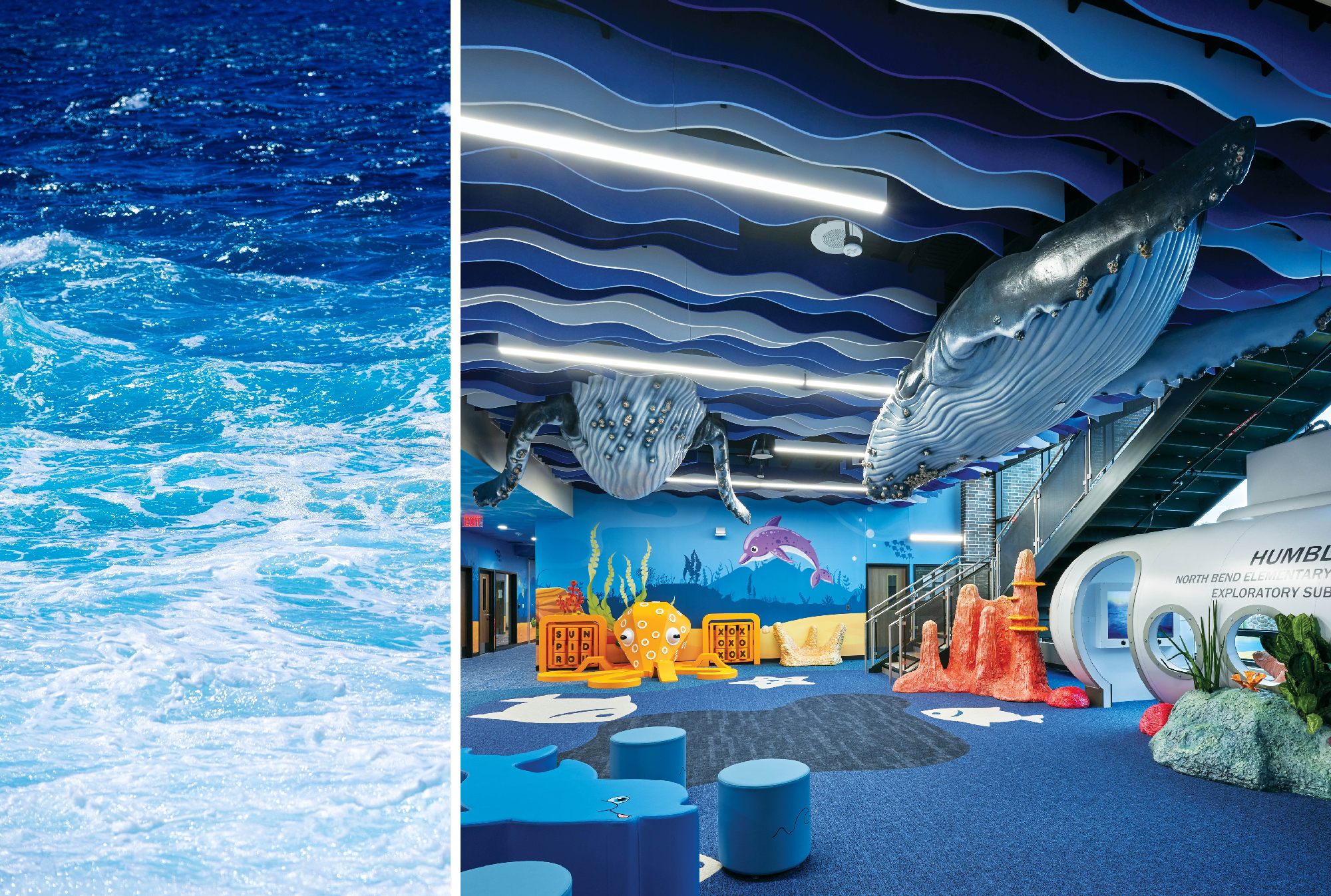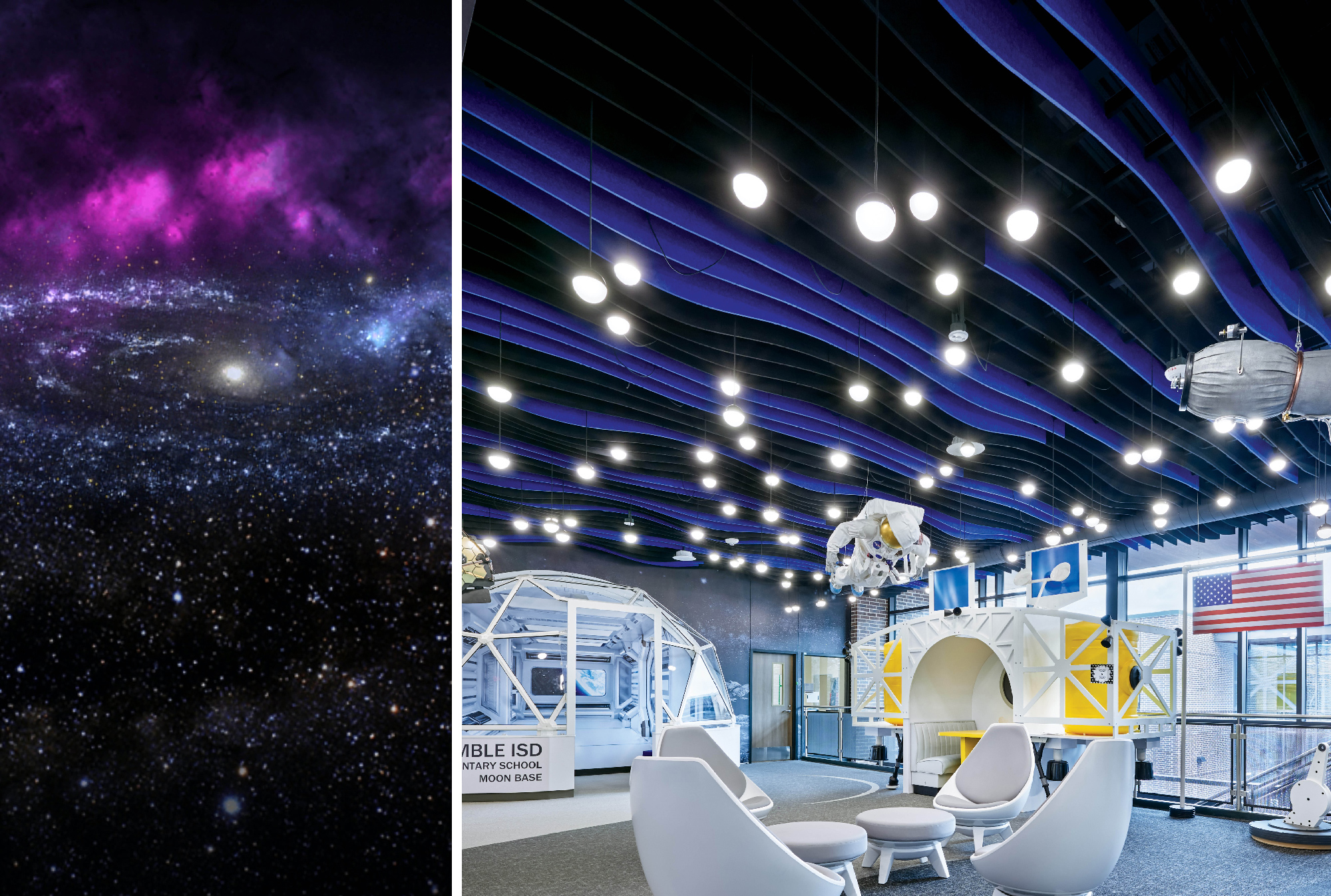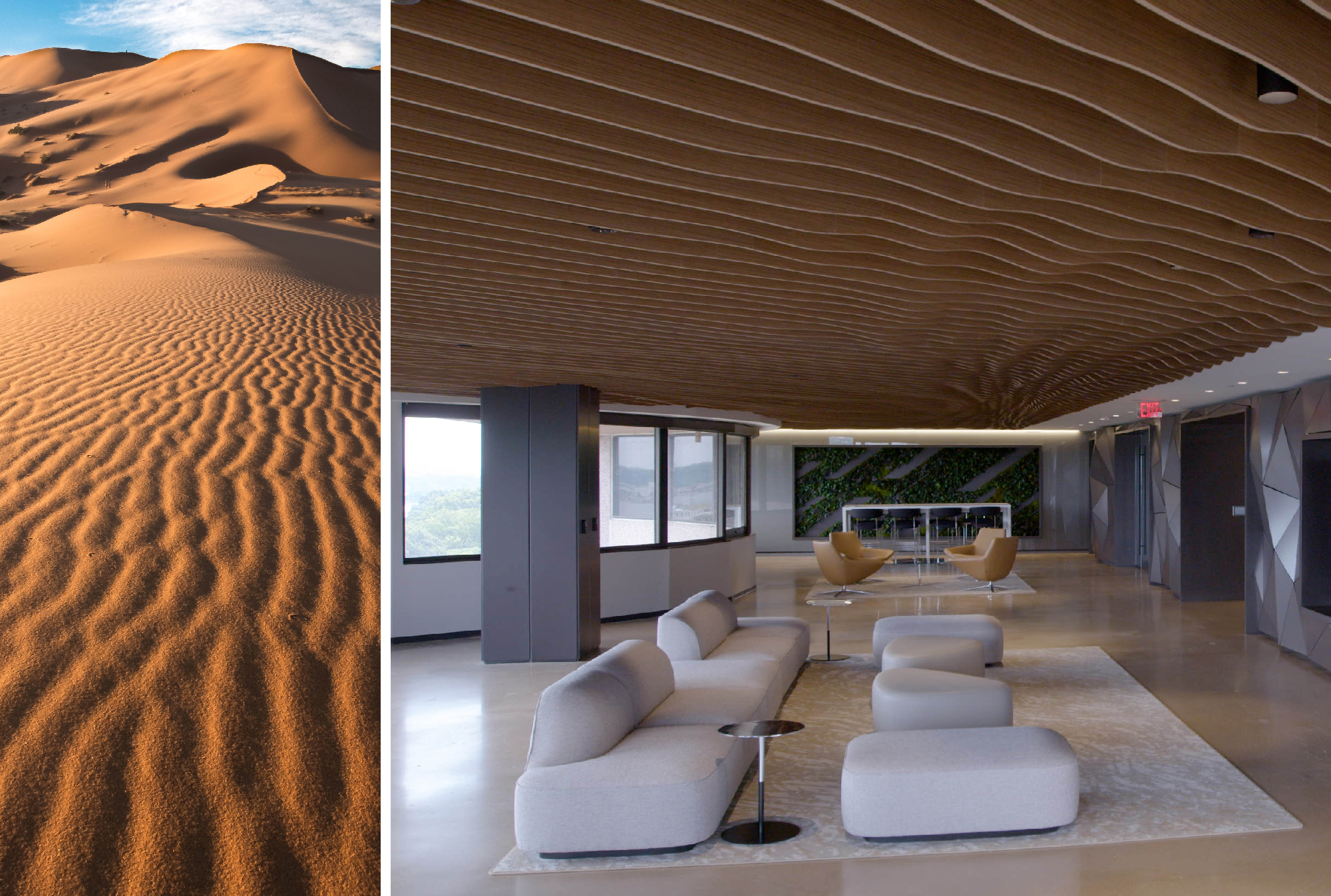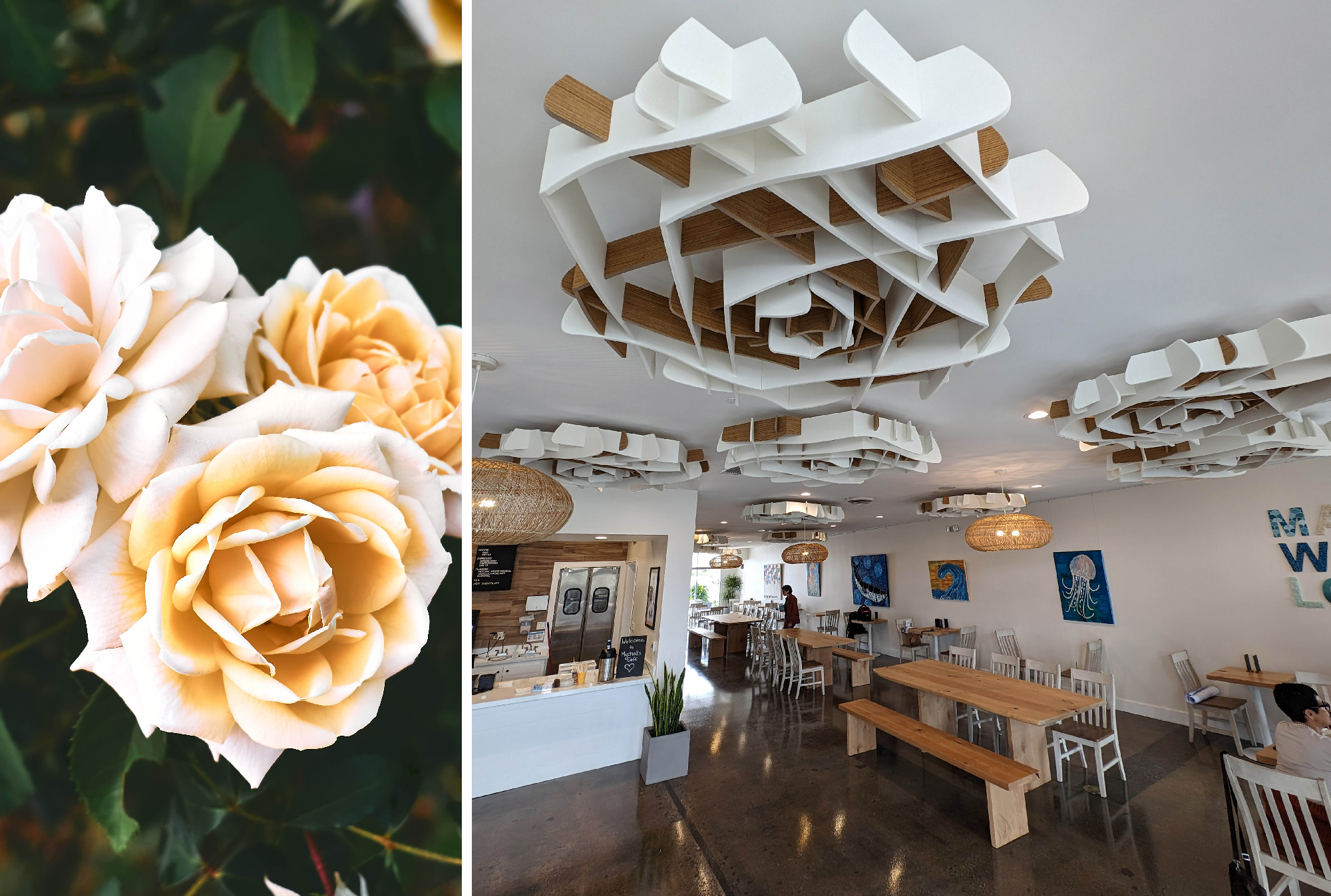When using these principles and tests to evaluate materials or products, it’s important to recognize that test results such as an NRC or Sabin number for a product aren’t the whole story. Rather, the type of building space, its size, its use, and the intended impact on people all need to be considered. Good acoustic design uses these numbers (derived in a laboratory setting) and translates them into a design that is applicable and appropriate to a specific space in a specific project. That means that design professionals need to be sure that the right test or standard is being used so it is relevant to their building situation. Whenever possible, it is best to work with a ceiling manufacturer who can be transparent about test results and real-world performance. Identifying someone who can work with the design team to provide this level of transparency can be the best way to achieve the intended acoustical results. Alternatively, it will be incumbent on the architect or other design professionals to refer to true NRC test documents, acoustical data, blogs, and/or independent research.

Photos: Anton Grassl
The appropriate use of color and natural lighting in ceiling design can enhance a space to make it inviting and appealing. Project: Confidential Biotech Company Location: Boston; Architect: Perkins&Will
INTERIOR ENVIRONMENTAL SENSITIVITY
Building interiors, including ceilings, create indoor environments that can have notable impacts on people through multiple means. Beyond good acoustics and experiences of sound, interior environmental quality is impacted by the following aspects of design as well:
Soundscaping
Sometimes, instead of eliminating or reducing sound in a space, there can be the deliberate intention to introduce some pleasant sounds into the space through electronic or other means. It can be as simple as some appropriate background music or more complex creations of “white noise” to mask other sounds and create a greater sense of privacy. Overall, soundscaping can be used to create a tranquil, peaceful, and ordered environment. This includes incorporating sound-absorbing materials in the ceiling to direct and control the sound being added, as well as to reduce noise pollution. In order to be most effective, designers should align the soundscape with the landscape or design intent of the building to create a cohesive experience.
Color Psychology
Color is a fundamental aspect of the visual and sensual experience of any building interior. Working with color is more than an aesthetic exercise, however, since it has direct connections to the psychological and emotional aspects of people. Different colors can affect mood and stress levels. For example, blue and green hues are often associated with calmness and relaxation, while red and yellow can be stimulating. Recognizing these impacts, different colors can be incorporated into different areas of a building to create a different feel in each space while maintaining relevance to the overall building design. By understanding both the theoretical and practical aspects of using color in this manner, the health and welfare of people can be improved.
When creating customized ceiling designs, some fundamental aspects of color theory can be applied such as the use of a color wheel to define complementary or disparate colors. The ceiling colors can be coordinated or contrasted with other colors in the space to create a final overall look. Keep in mind, though, that since color is basically based on light striking a surface, different types of electrical or natural lighting can have as much of an impact on the perceived color as the material itself.
Natural Light
Incorporating natural daylight into buildings is a fundamental yet sometimes challenging design issue. At the most basic level, sunlight provides natural lighting and a connection to the outdoors for the people inside the building. However, simply letting sunlight into a building means that the light level and quality can largely be uncontrolled – the building receives whatever the sun and sky provide. More sophisticated approaches focus on intentional, controlled daylighting including the locations of the light in the building, the intensity or amount of light, the color properties of the light, and the ability to disperse or diffuse the light so as to control glare.
A frequently referenced resource, particularly for government or institutional buildings is the Whole Building Design Guide. It discusses and defines daylighting for buildings of our era this way: “Daylighting is the controlled admission of natural light, direct sunlight, and diffused sky light into a building to reduce electric lighting and save energy.” It is noteworthy that it distinguishes natural light from direct sunlight and from diffused sky light. Each of these is indicative of different types of light quality. Regarding the benefits of daylighting, they cite: “By providing a direct link to the dynamic and perpetually evolving patterns of outdoor illumination, daylighting helps create a visually stimulating and productive environment for building occupants, while reducing as much as one-third of total building energy costs.” It is also commonly held that natural light in interior spaces helps to reduce stress and improve mood. All of this speaks to both the human benefits of natural light and to the economical and energy-efficient operation of the building itself.
Based on these benefits, many architects seek to incorporate appropriately sized skylights, clerestories, roof monitors, or other means to bring in natural light through a ceiling and into an occupied space. In many cases, this is possible in single-story spaces or upper levels. The key becomes controlling the light for quality, lack of glare, etc. In that case, the use of custom ceiling systems with vertical baffles, light-reflecting materials, or even translucent panels can all be incorporated to achieve the benefits of natural light while avoiding potential unwanted issues. For building spaces that don’t have access to a roof (i.e., multi-story buildings) there are some innovative strategies being used to mimic daylight by using LED lighting that is color-controlled to match the coloration of natural sunlight. Such lighting fixtures can be integrated into a ceiling and create the look and feel of natural lighting, with the same potential benefits to people. For particularly effective solutions, some designs can use a designed pattern of smaller spot lighting shining on ceiling elements designed to look like daylight hitting the leaves of a tree or other features. The overall effect is the creation of an indoor environment with a naturally appearing canopy above with streams of filtered light coming through.
Biophilic Design
A growing interior design trend that has been directly related to human health and welfare is the use of biophilia in buildings. Defined literally as a love of living things or a love of nature, biophilic design is a concept focused on increasing occupant connectivity to the natural environment in creative ways. Theorists argue that this approach taps into the hard wiring of human beings who, over the span of history, have developed an affinity for the life-supporting aspects of the natural world. In a post-pandemic era, biophilia has received more attention as a means to help people reconnect with nature and influence their general sense of well-being. Independent researchers have long been aware of the health and wellness benefits of such features in many different building environments.
When direct links to the outside aren’t practical or feasible, then there is another approach to integrating nature into buildings. In these cases, selecting products and systems that emulate nature through pattern selection, color, shape, and texture can be very effective. Designers can review examples of natural settings and then create a design solution for products that mimic the natural. This includes colors at the very basic level but can also emulate natural shapes to represent elements of landscaping, foliage, forest, or even water features.
Such large-scale, biophilic features can be incorporated into an overall interior design strategy through a customized ceiling and/or wall design. The use of three-dimensional baffles or other ceiling elements can be formed and fashioned to create the desired biophilic shapes. They can also be colored in a varied and natural way to emulate the condition that they are aiming to mimic. These patterns and design concepts can be used on the walls too, to create a fully immersive environment.
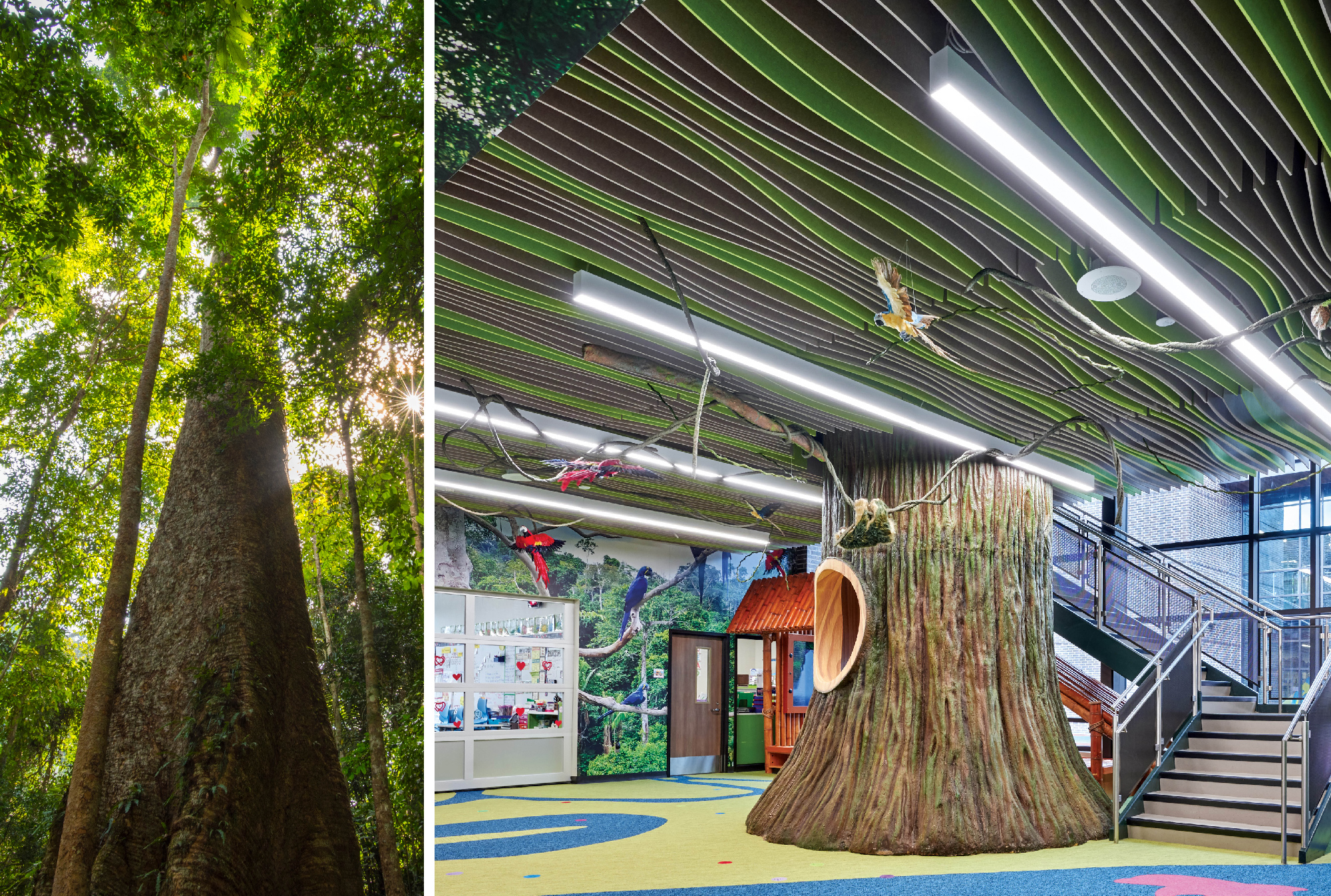
Photos courtesy of Armstrong World Industries
Customized ceilings can mimic nature for biophilic effects while still providing very good acoustical and lighting performance. Project: North Bend Elementary Location: Humble, Texas; Architect: PBK Architects
DESIGN INTEGRATION
While our focus has been on ceilings, it is always good to pull back and look at the bigger picture of the building design. Whatever ceiling system is being considered needs to be evaluated on the basis of its contributions to the overall design intent and functional needs. Since many different choices of products are available, along with custom design and fabrication options, designers can choose from a wide array of components and systems to find the best ones for a given project.
When putting a ceiling system design together, keep in mind that the challenge is often not just acoustics or just lighting, or just biophilia, etc. Rather, the design task is to blend all of those needs into one solution that is specifically tailored for the specific spaces and user circumstances of the spaces being designed. This is where custom ceiling designs can help architects and designers excel. By their nature, custom ceiling systems can achieve sought-after integration by using parts and pieces in the colors, textures, shapes, and patterns specifically needed. Each can be selected or designed according to the project goals of the system and the space in all of the ways discussed thus far. For example, integrated lighting can be combined into acoustical ceiling clouds; easy-to-install solutions can have custom biophilic looks; or lighting can be integrated across the entire ceiling in order to round out the experience and meet functional requirements.
CEILINGS AND GREEN BUILDING DESIGN
When custom-suspended ceilings are incorporated into a building design or renovation, there are several contributions that may be made using LEED criteria due to their inherent material make-up, the way that they are used, and general characteristics. These can include the following.
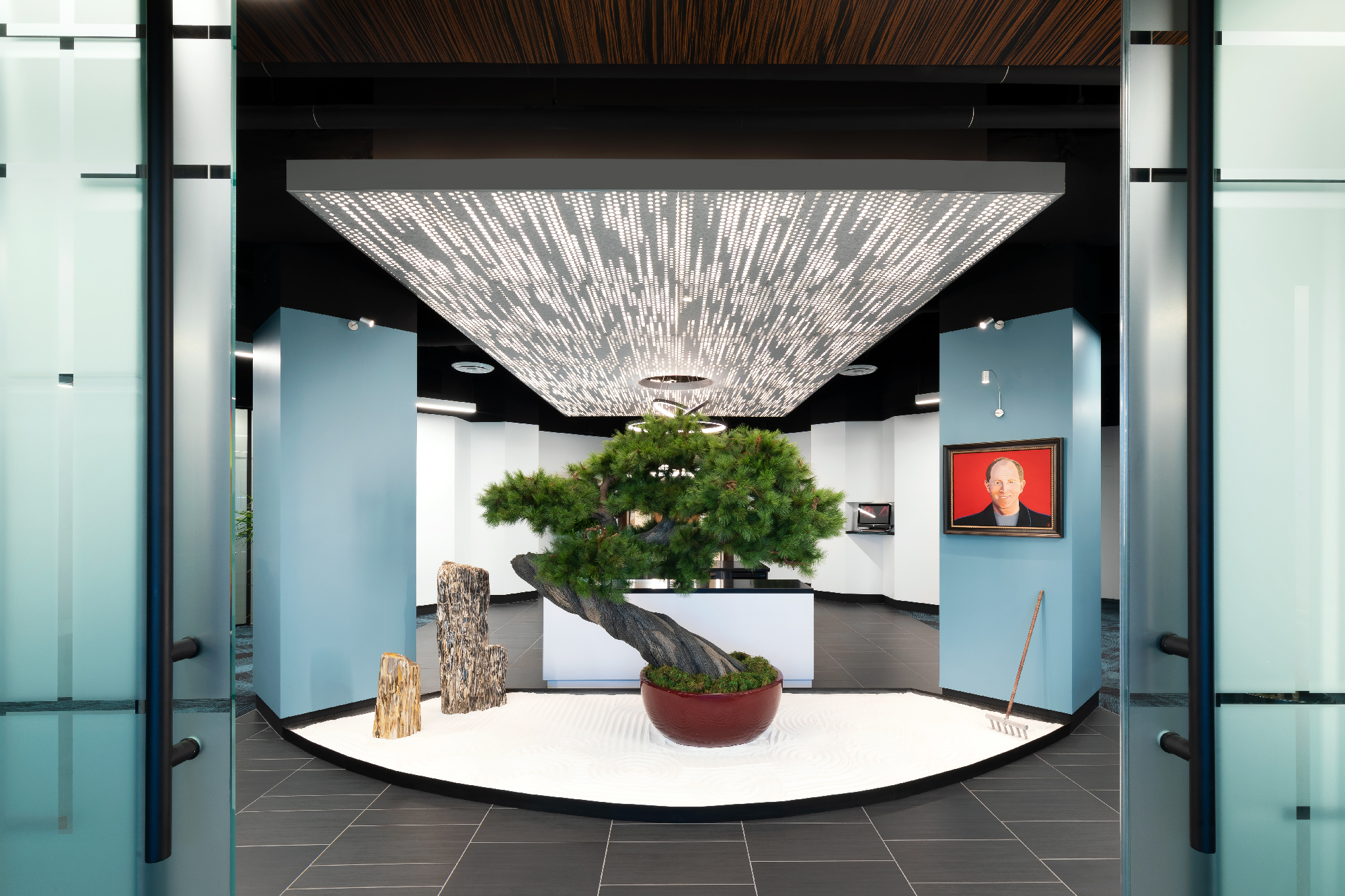
Photo: Costea Photo
Ceilings can be selected based on their ability to contribute to green building rating systems through material content, lighting qualities, and indoor environmental quality. Project: CMM; Location: Woodland Hills, California; Architect: ENV
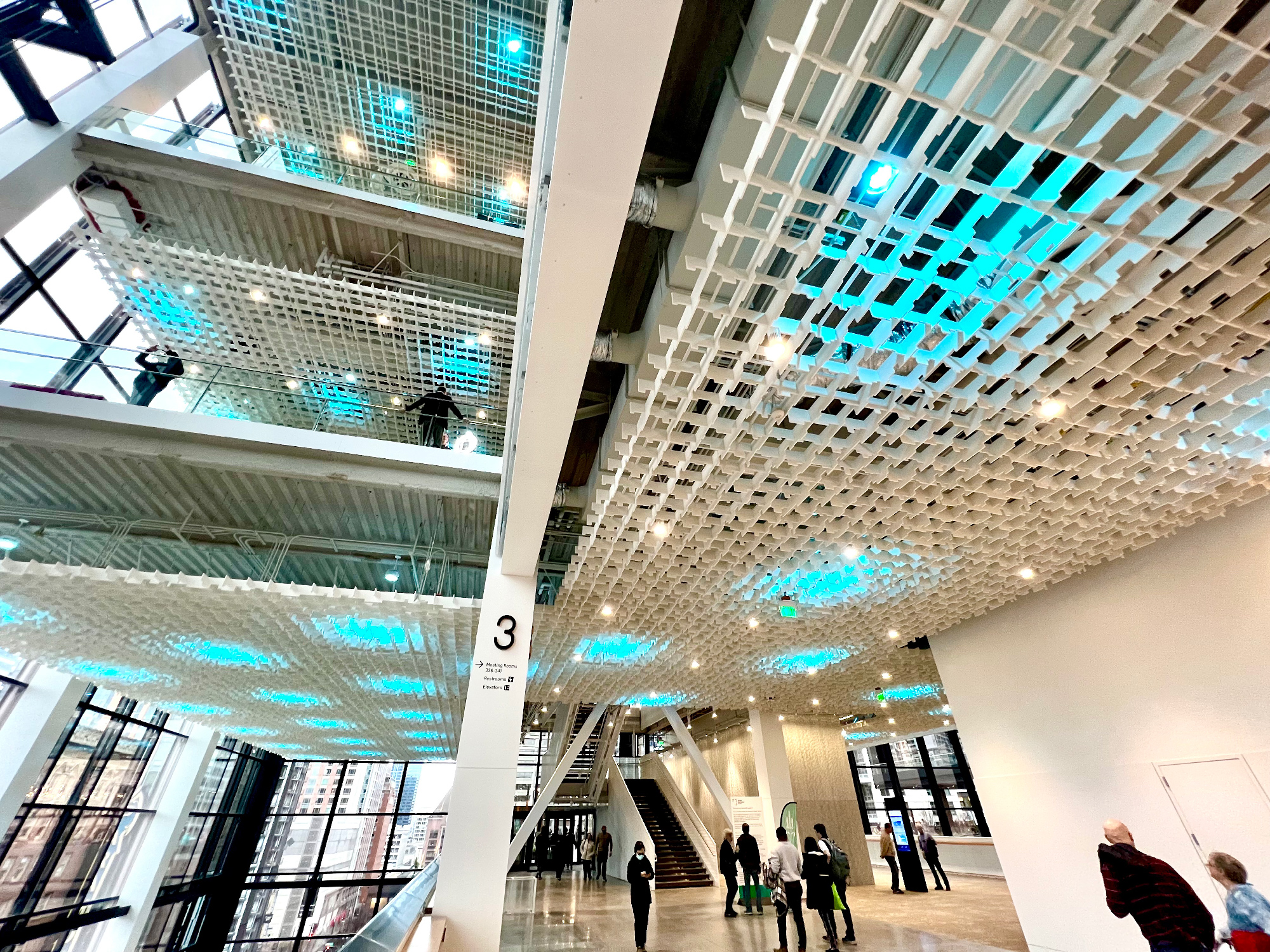
Photo: Chris West
Properly specifying complete custom ceiling solutions is the key to successful performance and appearance. Project: Seattle Convention Center Summit Building; Location: Seattle; Architect: LMN Architects.
Optimizing Energy Use
Energy performance in a building is usually directly related to two building energy systems – lighting and HVAC. Ceilings can be a key component in both of these. Energy-efficient lighting can be integrated into the ceiling design, so it provides the needed level of light with a minimum requirement for electricity. Using a ceiling design that allows for integrating skylights means that the use of electricity for lighting is further diminished. The size, shape, and color of the ceiling components themselves can help with reflecting light, whether electrical or natural, thus maximizing the lighting that is available and controlling energy use. Similar efficiencies can be obtained when HVAC diffusers, grilles, and intakes are incorporated into ceiling designs. The spacing, location, and sizing of these components can be integrated into a ceiling design so that the efficiency of the total system they are connected to is optimized without negative impacts on performance.
Materials and Resources
When looking at a life cycle assessment (LCA) for a building, several traits of ceilings can help produce very favorable results. First, is its basic material makeup. The use of Environmental Product Declarations (EPDs) helps designers assess the materials used in ceiling products and the degree to which those materials impact the environment. For some settings, the use of Health Product Declarations (HPDs) is appropriate if there is enhanced concern about the impact of materials on human health. Second is the amount of embodied energy or embodied carbon found in the products. This aspect of building materials has received heightened attention in recent years due to the relatively high impact that construction materials can have on greenhouse gas emissions. The use of recycled content, and the ability to recycle and salvage materials help to contribute to this aspect of the products. Further, working with a single source supplier can limit or reduce the amount of scrap and construction waste on a site. Finally, the longevity and durability of the material are significant since a custom, durable ceiling may not need to be replaced during the life of the building in contrast to other ceiling systems that could need to be replaced repeatedly.
Indoor Environmental Quality
When natural and tested materials are used, custom ceilings can exhibit very favorable traits for indoor environments. By integrating skylights into the ceilings, natural daylight can be added enhancing the human experience. Biophilic design, as we have discussed, can be incorporated to further contribute to the general health and wellness attributes that are possible. From a product standpoint, ceiling products are typically made with low-emitting materials that are pre-finished with low volatile organic compound (VOC) content. Further, no paints, coatings, adhesives, or harmful sealants are usually needed during installation, so the potential for formaldehyde or other on-site VOCs is reduced.
Custom, innovative ceilings have the potential to pursue some innovation in design credits under LEED and other programs too. Even without that, it should be clear that the products currently available can help buildings achieve green building design certification.
SPECIFYING CUSTOM CEILING
When specifying custom ceiling systems, it is advisable to first talk with manufacturers or suppliers of such systems to understand and assess the available product offerings and possibilities. It is also helpful to review industry standards and model specifications that can be edited for specific projects, whether new construction or renovation. In a standard, 3-part specification format following the CSI or MasterFormat system, ceilings are found in Division 09 Finishes usually under Section 09 50 00 or a subsection thereunder. Some of the relevant items to address are highlighted as follows.
Part 1 - General
The scope of the specified work for the custom ceiling system and related work as well as any definitions should be called out. It is advisable to call for a pre-installation meeting and to request submittals based on the project needs, including the request for LEED documentation if any relevant credits are being pursued. Quality assurance can be addressed by calling out the relevant ASTM and other standards that need to be met for the materials selected. Project conditions and product storage should all be addressed in a typical fashion with a particular emphasis on protecting the materials from moisture to avoid damage.
Part 2 - Products
ll of the different performance and material criteria for the ceiling components being specified need to be called out. This includes the ceiling tiles, baffles, suspension systems, hardware, accessories, and any other components or parts. The specific material listings following the ASTM and ANSI standards should be identified including any allowable variations. Since most custom ceiling systems are pre-finished, the colors, textures, and patterns of all exposed components need to be identified and referenced to the drawings as appropriate. Any related materials or accessories provided by others should either be specified in this spec section or be referenced in other relevant specification sections.
Part 3 - Execution
As with any site-installed product, the installation requires multiple steps which need to be clearly articulated in the specification in order to achieve the best results.
- Examination and Preparation: The importance of this step should always be stressed. In addition to the architect, the installer and general contractor or construction manager should review and examine the substrate for conditions that may affect the installation or the overall performance of the ceiling. This can include a determination of where or where suspension wires, rods, etc., should be installed. It may also require an assessment of walls and other surfaces that the ceiling is abutting. Any issues will need to be corrected, likely by the general contractor, if they are found to be out of compliance with the stated requirements.
- Installation: The recommendations and procedures of the ceiling manufacturer as well as the applicable requirements of codes and standards should be followed in all cases.
- Protection: Once installed and finished, the surface should likely be able to withstand use by remaining construction personnel on the project. However, the general contractor should be instructed to cover and protect any surfaces that are vulnerable to damage.
When designed, specified, and installed correctly, a custom ceiling system can readily provide the desired look, the general health and wellness benefits, and the long-term performance characteristics that are intended.
CONCLUSION
Custom ceiling systems can meet a full range of design and performance needs. Coordination is needed to ensure that all of the different ceiling components work together. Whenever possible, a single source responsibility for the entire system is preferred, starting with design assistance all the way through complete installation.
Peter J. Arsenault, FAIA, NCARB, LEED AP is a nationally known architect who has authored nearly 300 continuing education courses focused on advancing building performance through better design. www.pjaarch.com, www.linkedin.com/in/pjaarch
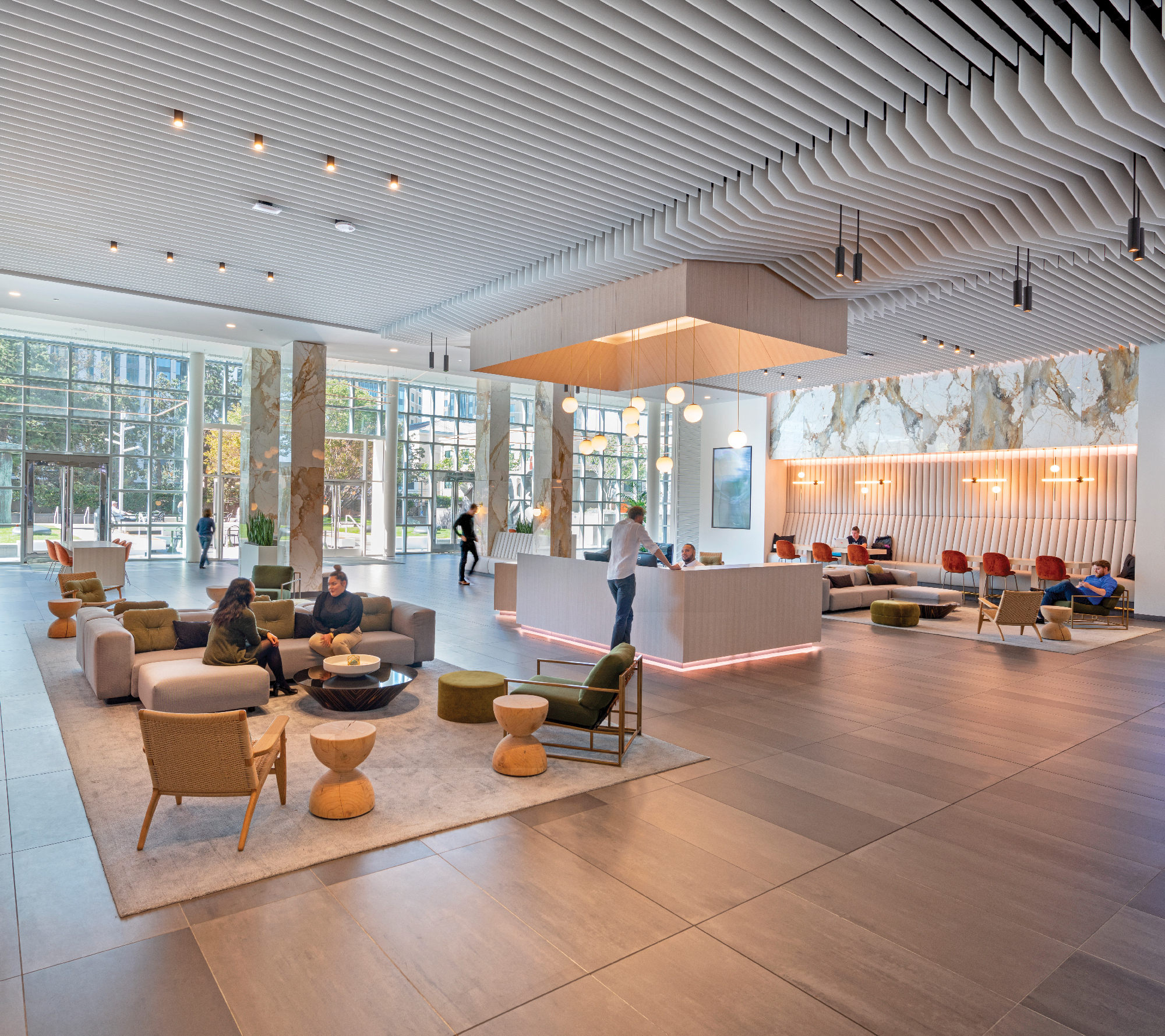
Photo by Jasper Sanidad. “1111 Broadway” Oakland, CA, Rios Clementi Hale Studios
Ceilings can provide a significant design element when they are customized to suit an interior space for an enhanced experience.
The design of building interiors is often focused on walls, floors, and furnishings perhaps because of a perception that these are where people interact most with the indoor environment. However, just as we experience a beautiful sky outdoors, the design of a ceiling indoors can have a significant impact on the look, feel, and character of an interior space. This happens because people react to more than just the visual aspects of a ceiling, which, while important, belies the other ways we interact and perceive spaces. This includes the impact of a ceiling on acoustics in a space, on achieving a sense of either motion or stillness or creating a benign or dramatic experience. This course covers many of these different aspects of ceiling design and the ways that they can be customized to suit many different design goals in all types of buildings.
CEILING SYSTEMS AS PART OF INTERIOR DESIGN
Ceilings in commercial and institutional buildings don’t need to be boring. For a lot of years, the norm has been to assume the use of a suspended ceiling with a rectilinear grid and white acoustical tile. Manufacturers have offered some innovations over time, but they have mostly been two-dimensional solutions, nonetheless. More recently, some three-dimensional options have emerged with a variety of aesthetic and performance features and capabilities. As the appeal for high-performance, high-visual impact ceilings has grown, and the costs have become more competitive, there are more options for ceilings to be part of an overall interior design scheme than ever before.
One current aspect of ceiling design is that it can be customized to suit the specific needs of a project. Systems are available that use standardized components to create custom appearances as well as the possibility of creating custom pieces from some manufacturers. In so doing, these advanced ceiling systems provide a full range of features and capabilities as part of the overall design of spaces and rooms. Among the possibilities, the following is a representative list:
- Acoustics: Suspended ceilings have always been a reliable means to provide acoustic comfort for people in different conditions and in all building types. The key to a successful acoustical design is to select and design a ceiling system that has the best acoustical properties for a particular space. Not all conditions are the same, so an improper selection or design can provide disappointing or unwelcome results.
- Visuals: Ceilings, custom or otherwise, can be designed not only for pure aesthetic appearance but also to induce occupant health and well-being. This can be achieved through color and pattern selection creating spaces that promote relaxation and reduce stress.
- Biophilia: Ceilings can be customized to incorporate three-dimensional organic shapes inspired by nature. This reflection or mimicry of nature can be achieved through shapes, colors, and patterns of ceiling components. Such an approach can be specific to particular rooms or part of an overall building design.
- Lighting: The incorporation of integrated lighting into ceilings has been a mainstay of suspended ceiling design and layout. Customized ceiling designs can also incorporate customized lighting options, particularly with alternatives to standard lay-in lighting fixtures.
By paying attention to these different aspects of ceiling design, building interiors can be enhanced for people experiencing a space, address multiple human senses, and contribute to health and wellness.
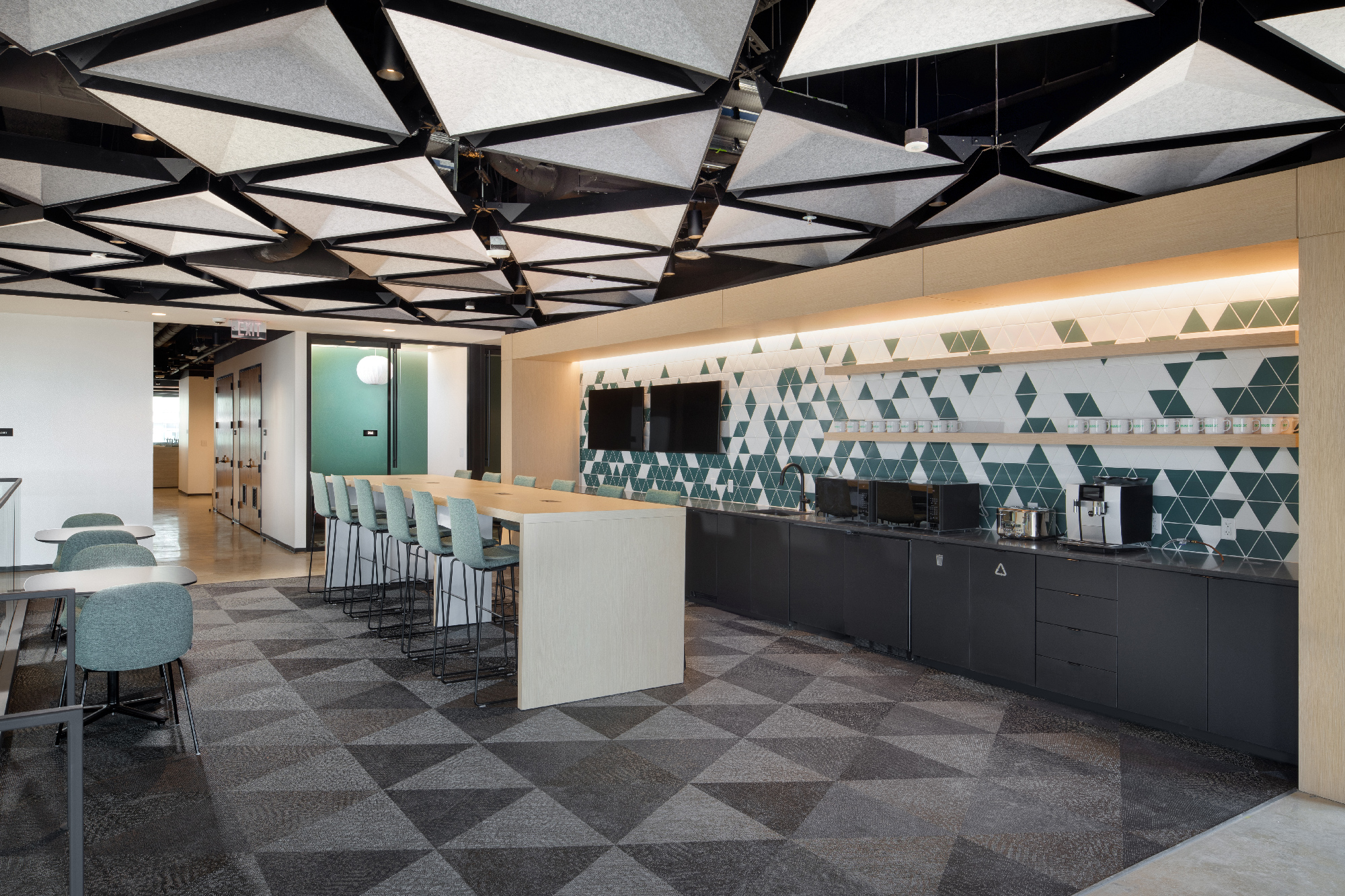
Photo: Jenn Verrier
Customized ceilings can creatively enhance the experience of being in an interior space. Project: Neustar; Location: Reston, Virginia; Architect: HKS Architects
ACOUSTIC COMFORT FROM CEILINGS
As noted, one of the primary functions that ceilings provide in many situations is acoustical control for the comfort and benefit of those who are in the rooms and spaces of a building. In order to understand some of the ways in which ceilings can enhance or detract from acoustical performance, the following principles are presented as a basis for good design.
Acoustical Energy
Sound is energy that radiates out from a source, just like heat and light are radiative energy. Understanding how to direct, restrict, or otherwise control sound is similar to how we do the same with other types of energy.
In the case of interior acoustics, design strategies focus on what happens when sound waves travel into or through a space and meet a surface such as a ceiling. The particular effect that surface will have on the emitted sound waves will depend directly on the acoustic characteristics of the material encountered. All materials, however, will exhibit differing levels of the same three actions:
- Reflection: Some percentage of the sound will bounce off of the surface and be reflected back into the space. If the material is highly reflective, it will make this condition severe causing echoes or seemingly intensified sound levels. While this might be desirable in some situations, it is not common for most commercial and institutional settings.
- Absorption: When ceiling materials are softer and porous, they are very good at absorbing sound waves and dissipating the energy. This has the effect of softening the sound and reducing echoes, making it easier to understand conversation and other sounds.
- Transmittance: When some of the sound energy is not reflected or absorbed by a ceiling, it is directly transmitted through the ceiling material or the assembly to the other side. This means that people in adjacent spaces may hear what is going on “next door” or on a floor above or below the source of the transmitted sound.
Note that these three characteristics of sound are true for all conditions and with all materials. We focus our attention only on ceilings here.

Images courtesy of Arktura
In order to predict and control acoustic performance in buildings, many different aspects of sound need to be taken into account.
Acoustical Performance
Understanding the basic ways that sound behaves when it encounters different materials or assemblies is the starting point. The next logical question is how much of each occurs. By using standard methods of measuring or testing materials and assemblies, their acoustical properties can be quantified. This information can be used to help control, direct, or reduce the sound experienced in well-designed spaces. The common means to measure sound reflectance, absorption, and transmission are as follows:
- Noise Reduction Coefficient (NRC): Individual materials can be formally tested according to ASTM C423 “Standard Test Method for Sound Absorption and Sound Absorption Coefficients by the Reverberation Room Method.” This standard is used to measure the rate of sound absorption of materials on a scale of zero to one. As such, NRC ratings of a material are commonly viewed as a percentage. For example, an NRC of 0.75 means 75% of the sound energy that strikes a tested material is absorbed instead of being reflected or transmitted.
- NRC vs. Sound Absorption Average (SAA): The NRC rating is the average of the sound absorption coefficients of four specific sound frequencies: 250, 500, 1000, and 2000hz.By contrast, the Sound Absorption Average (SAA) rating is the average of the sound absorption coefficients of an octave range that includes 12 different frequencies between 200 and 2500 Hz, thus providing a more complete understanding of sound performance. In both the NRC and the SAA tests, the scale of results goes from 0 (perfect reflection/ no absorption) to 1 (perfect absorption/ no reflection). This scale is used to measure the effectiveness of ceiling tiles, baffles, and other acoustic design elements. Depending on the test setup, some results can exceed 1. When acoustical ceiling products are tested, they generally are designed to achieve very high NRC and/or SAA ratings. However, those results will vary based on the circumstances of how it is used, the thickness and makeup of the materials, and variations between products.
- Sabin: When acoustic materials are placed to hang down vertically in a space instead of horizontally on a ceiling, then a different sound measurement is needed. In this case, a Sabin is used as the measure of the total sound absorption provided by an individual sound absorber such as a ceiling baffle when installed within an architectural space. Absorption in Sabin is also measured according to ASTM C423. The number of Sabin per unit is approximately equal to the total surface area of the unit (in square feet) that is exposed to sound, multiplied by the measured absorption coefficient of the material. Some ceiling products are ideal for this type of application and commonly show test results with a very high absorption coefficient and Sabin ratings.
- Sound Transmission Class (STC): This is a standard test rating that is often provided by manufacturers as a means for designers to select appropriate materials for sound transmittance in buildings. Essentially, the STC rating is a way to determine how much sound (measured in decibels) is reduced as it passes through a material or assembly. The higher the STC rating, the more sound that does not transmit. For most building conditions, an STC rating on the order of 40 – 45 is appropriate for most normal conditions but ranges between 35 and 55 are also common. For ceiling design, the STC rating should be used to measure the sound that is being transmitted through the entire ceiling assembly, not just an individual ceiling product.
When using these principles and tests to evaluate materials or products, it’s important to recognize that test results such as an NRC or Sabin number for a product aren’t the whole story. Rather, the type of building space, its size, its use, and the intended impact on people all need to be considered. Good acoustic design uses these numbers (derived in a laboratory setting) and translates them into a design that is applicable and appropriate to a specific space in a specific project. That means that design professionals need to be sure that the right test or standard is being used so it is relevant to their building situation. Whenever possible, it is best to work with a ceiling manufacturer who can be transparent about test results and real-world performance. Identifying someone who can work with the design team to provide this level of transparency can be the best way to achieve the intended acoustical results. Alternatively, it will be incumbent on the architect or other design professionals to refer to true NRC test documents, acoustical data, blogs, and/or independent research.

Photos: Anton Grassl
The appropriate use of color and natural lighting in ceiling design can enhance a space to make it inviting and appealing. Project: Confidential Biotech Company Location: Boston; Architect: Perkins&Will
INTERIOR ENVIRONMENTAL SENSITIVITY
Building interiors, including ceilings, create indoor environments that can have notable impacts on people through multiple means. Beyond good acoustics and experiences of sound, interior environmental quality is impacted by the following aspects of design as well:
Soundscaping
Sometimes, instead of eliminating or reducing sound in a space, there can be the deliberate intention to introduce some pleasant sounds into the space through electronic or other means. It can be as simple as some appropriate background music or more complex creations of “white noise” to mask other sounds and create a greater sense of privacy. Overall, soundscaping can be used to create a tranquil, peaceful, and ordered environment. This includes incorporating sound-absorbing materials in the ceiling to direct and control the sound being added, as well as to reduce noise pollution. In order to be most effective, designers should align the soundscape with the landscape or design intent of the building to create a cohesive experience.
Color Psychology
Color is a fundamental aspect of the visual and sensual experience of any building interior. Working with color is more than an aesthetic exercise, however, since it has direct connections to the psychological and emotional aspects of people. Different colors can affect mood and stress levels. For example, blue and green hues are often associated with calmness and relaxation, while red and yellow can be stimulating. Recognizing these impacts, different colors can be incorporated into different areas of a building to create a different feel in each space while maintaining relevance to the overall building design. By understanding both the theoretical and practical aspects of using color in this manner, the health and welfare of people can be improved.
When creating customized ceiling designs, some fundamental aspects of color theory can be applied such as the use of a color wheel to define complementary or disparate colors. The ceiling colors can be coordinated or contrasted with other colors in the space to create a final overall look. Keep in mind, though, that since color is basically based on light striking a surface, different types of electrical or natural lighting can have as much of an impact on the perceived color as the material itself.
Natural Light
Incorporating natural daylight into buildings is a fundamental yet sometimes challenging design issue. At the most basic level, sunlight provides natural lighting and a connection to the outdoors for the people inside the building. However, simply letting sunlight into a building means that the light level and quality can largely be uncontrolled – the building receives whatever the sun and sky provide. More sophisticated approaches focus on intentional, controlled daylighting including the locations of the light in the building, the intensity or amount of light, the color properties of the light, and the ability to disperse or diffuse the light so as to control glare.
A frequently referenced resource, particularly for government or institutional buildings is the Whole Building Design Guide. It discusses and defines daylighting for buildings of our era this way: “Daylighting is the controlled admission of natural light, direct sunlight, and diffused sky light into a building to reduce electric lighting and save energy.” It is noteworthy that it distinguishes natural light from direct sunlight and from diffused sky light. Each of these is indicative of different types of light quality. Regarding the benefits of daylighting, they cite: “By providing a direct link to the dynamic and perpetually evolving patterns of outdoor illumination, daylighting helps create a visually stimulating and productive environment for building occupants, while reducing as much as one-third of total building energy costs.” It is also commonly held that natural light in interior spaces helps to reduce stress and improve mood. All of this speaks to both the human benefits of natural light and to the economical and energy-efficient operation of the building itself.
Based on these benefits, many architects seek to incorporate appropriately sized skylights, clerestories, roof monitors, or other means to bring in natural light through a ceiling and into an occupied space. In many cases, this is possible in single-story spaces or upper levels. The key becomes controlling the light for quality, lack of glare, etc. In that case, the use of custom ceiling systems with vertical baffles, light-reflecting materials, or even translucent panels can all be incorporated to achieve the benefits of natural light while avoiding potential unwanted issues. For building spaces that don’t have access to a roof (i.e., multi-story buildings) there are some innovative strategies being used to mimic daylight by using LED lighting that is color-controlled to match the coloration of natural sunlight. Such lighting fixtures can be integrated into a ceiling and create the look and feel of natural lighting, with the same potential benefits to people. For particularly effective solutions, some designs can use a designed pattern of smaller spot lighting shining on ceiling elements designed to look like daylight hitting the leaves of a tree or other features. The overall effect is the creation of an indoor environment with a naturally appearing canopy above with streams of filtered light coming through.
Biophilic Design
A growing interior design trend that has been directly related to human health and welfare is the use of biophilia in buildings. Defined literally as a love of living things or a love of nature, biophilic design is a concept focused on increasing occupant connectivity to the natural environment in creative ways. Theorists argue that this approach taps into the hard wiring of human beings who, over the span of history, have developed an affinity for the life-supporting aspects of the natural world. In a post-pandemic era, biophilia has received more attention as a means to help people reconnect with nature and influence their general sense of well-being. Independent researchers have long been aware of the health and wellness benefits of such features in many different building environments.
When direct links to the outside aren’t practical or feasible, then there is another approach to integrating nature into buildings. In these cases, selecting products and systems that emulate nature through pattern selection, color, shape, and texture can be very effective. Designers can review examples of natural settings and then create a design solution for products that mimic the natural. This includes colors at the very basic level but can also emulate natural shapes to represent elements of landscaping, foliage, forest, or even water features.
Such large-scale, biophilic features can be incorporated into an overall interior design strategy through a customized ceiling and/or wall design. The use of three-dimensional baffles or other ceiling elements can be formed and fashioned to create the desired biophilic shapes. They can also be colored in a varied and natural way to emulate the condition that they are aiming to mimic. These patterns and design concepts can be used on the walls too, to create a fully immersive environment.

Photos courtesy of Armstrong World Industries
Customized ceilings can mimic nature for biophilic effects while still providing very good acoustical and lighting performance. Project: North Bend Elementary Location: Humble, Texas; Architect: PBK Architects
DESIGN INTEGRATION
While our focus has been on ceilings, it is always good to pull back and look at the bigger picture of the building design. Whatever ceiling system is being considered needs to be evaluated on the basis of its contributions to the overall design intent and functional needs. Since many different choices of products are available, along with custom design and fabrication options, designers can choose from a wide array of components and systems to find the best ones for a given project.
When putting a ceiling system design together, keep in mind that the challenge is often not just acoustics or just lighting, or just biophilia, etc. Rather, the design task is to blend all of those needs into one solution that is specifically tailored for the specific spaces and user circumstances of the spaces being designed. This is where custom ceiling designs can help architects and designers excel. By their nature, custom ceiling systems can achieve sought-after integration by using parts and pieces in the colors, textures, shapes, and patterns specifically needed. Each can be selected or designed according to the project goals of the system and the space in all of the ways discussed thus far. For example, integrated lighting can be combined into acoustical ceiling clouds; easy-to-install solutions can have custom biophilic looks; or lighting can be integrated across the entire ceiling in order to round out the experience and meet functional requirements.
CEILINGS AND GREEN BUILDING DESIGN
When custom-suspended ceilings are incorporated into a building design or renovation, there are several contributions that may be made using LEED criteria due to their inherent material make-up, the way that they are used, and general characteristics. These can include the following.

Photo: Costea Photo
Ceilings can be selected based on their ability to contribute to green building rating systems through material content, lighting qualities, and indoor environmental quality. Project: CMM; Location: Woodland Hills, California; Architect: ENV

Photo: Chris West
Properly specifying complete custom ceiling solutions is the key to successful performance and appearance. Project: Seattle Convention Center Summit Building; Location: Seattle; Architect: LMN Architects.
Optimizing Energy Use
Energy performance in a building is usually directly related to two building energy systems – lighting and HVAC. Ceilings can be a key component in both of these. Energy-efficient lighting can be integrated into the ceiling design, so it provides the needed level of light with a minimum requirement for electricity. Using a ceiling design that allows for integrating skylights means that the use of electricity for lighting is further diminished. The size, shape, and color of the ceiling components themselves can help with reflecting light, whether electrical or natural, thus maximizing the lighting that is available and controlling energy use. Similar efficiencies can be obtained when HVAC diffusers, grilles, and intakes are incorporated into ceiling designs. The spacing, location, and sizing of these components can be integrated into a ceiling design so that the efficiency of the total system they are connected to is optimized without negative impacts on performance.
Materials and Resources
When looking at a life cycle assessment (LCA) for a building, several traits of ceilings can help produce very favorable results. First, is its basic material makeup. The use of Environmental Product Declarations (EPDs) helps designers assess the materials used in ceiling products and the degree to which those materials impact the environment. For some settings, the use of Health Product Declarations (HPDs) is appropriate if there is enhanced concern about the impact of materials on human health. Second is the amount of embodied energy or embodied carbon found in the products. This aspect of building materials has received heightened attention in recent years due to the relatively high impact that construction materials can have on greenhouse gas emissions. The use of recycled content, and the ability to recycle and salvage materials help to contribute to this aspect of the products. Further, working with a single source supplier can limit or reduce the amount of scrap and construction waste on a site. Finally, the longevity and durability of the material are significant since a custom, durable ceiling may not need to be replaced during the life of the building in contrast to other ceiling systems that could need to be replaced repeatedly.
Indoor Environmental Quality
When natural and tested materials are used, custom ceilings can exhibit very favorable traits for indoor environments. By integrating skylights into the ceilings, natural daylight can be added enhancing the human experience. Biophilic design, as we have discussed, can be incorporated to further contribute to the general health and wellness attributes that are possible. From a product standpoint, ceiling products are typically made with low-emitting materials that are pre-finished with low volatile organic compound (VOC) content. Further, no paints, coatings, adhesives, or harmful sealants are usually needed during installation, so the potential for formaldehyde or other on-site VOCs is reduced.
Custom, innovative ceilings have the potential to pursue some innovation in design credits under LEED and other programs too. Even without that, it should be clear that the products currently available can help buildings achieve green building design certification.
SPECIFYING CUSTOM CEILING
When specifying custom ceiling systems, it is advisable to first talk with manufacturers or suppliers of such systems to understand and assess the available product offerings and possibilities. It is also helpful to review industry standards and model specifications that can be edited for specific projects, whether new construction or renovation. In a standard, 3-part specification format following the CSI or MasterFormat system, ceilings are found in Division 09 Finishes usually under Section 09 50 00 or a subsection thereunder. Some of the relevant items to address are highlighted as follows.
Part 1 - General
The scope of the specified work for the custom ceiling system and related work as well as any definitions should be called out. It is advisable to call for a pre-installation meeting and to request submittals based on the project needs, including the request for LEED documentation if any relevant credits are being pursued. Quality assurance can be addressed by calling out the relevant ASTM and other standards that need to be met for the materials selected. Project conditions and product storage should all be addressed in a typical fashion with a particular emphasis on protecting the materials from moisture to avoid damage.
Part 2 - Products
ll of the different performance and material criteria for the ceiling components being specified need to be called out. This includes the ceiling tiles, baffles, suspension systems, hardware, accessories, and any other components or parts. The specific material listings following the ASTM and ANSI standards should be identified including any allowable variations. Since most custom ceiling systems are pre-finished, the colors, textures, and patterns of all exposed components need to be identified and referenced to the drawings as appropriate. Any related materials or accessories provided by others should either be specified in this spec section or be referenced in other relevant specification sections.
Part 3 - Execution
As with any site-installed product, the installation requires multiple steps which need to be clearly articulated in the specification in order to achieve the best results.
- Examination and Preparation: The importance of this step should always be stressed. In addition to the architect, the installer and general contractor or construction manager should review and examine the substrate for conditions that may affect the installation or the overall performance of the ceiling. This can include a determination of where or where suspension wires, rods, etc., should be installed. It may also require an assessment of walls and other surfaces that the ceiling is abutting. Any issues will need to be corrected, likely by the general contractor, if they are found to be out of compliance with the stated requirements.
- Installation: The recommendations and procedures of the ceiling manufacturer as well as the applicable requirements of codes and standards should be followed in all cases.
- Protection: Once installed and finished, the surface should likely be able to withstand use by remaining construction personnel on the project. However, the general contractor should be instructed to cover and protect any surfaces that are vulnerable to damage.
When designed, specified, and installed correctly, a custom ceiling system can readily provide the desired look, the general health and wellness benefits, and the long-term performance characteristics that are intended.
CONCLUSION
Custom ceiling systems can meet a full range of design and performance needs. Coordination is needed to ensure that all of the different ceiling components work together. Whenever possible, a single source responsibility for the entire system is preferred, starting with design assistance all the way through complete installation.
Peter J. Arsenault, FAIA, NCARB, LEED AP is a nationally known architect who has authored nearly 300 continuing education courses focused on advancing building performance through better design. www.pjaarch.com, www.linkedin.com/in/pjaarch





